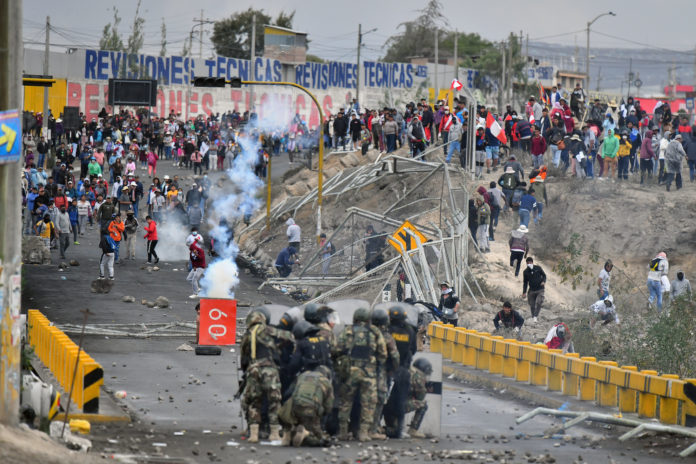

Like most days, Reuters photojournalist Sebastían Castañeda started his day on Jan. 23 by playing with his three-month-old daughter, whom he said is his “emotional fuel,” before preparing to photograph civil unrest and political mayhem in Peru.
He made sure he had everything he needed: a bulletproof vest, extra batteries for his camera, empty SD cards and other essentials. Then he checked in with his fellow journalists to coordinate where to meet.
“We always go in groups and cover in groups because it is always important to check how your colleagues are doing,” said Castañeda in an interview in Spanish.
“Most protests are rocks from one side [and] from the other, rubber bullets and tear gas.”
He has covered many protests in his home country, so he said he is used to this bleak scene.
Castañeda said his job is to photograph both sides of a story, which is how he often gets caught in the middle of violence — sometimes from protesters; sometimes from police officers.
But that day, it was from both.
As he was taking pictures, he noticed the tension between hundreds of protesters and police gradually getting worse until violence erupted. While the chaos unfolded, he got hit in his testicles by a rock.
“It was very painful and I had to step away from the protests for a while. A colleague had to make sure I was okay,” said Castañeda. “I had to lie on the ground and even the police approached me and asked if I needed an ambulance.”
Later that day, Castañeda was shot in the leg with rubber bullets by police.
“The police were very far away, like 50 meters away, so it wasn’t so bad,” he said.
“The rock hurt more, honestly.”
The protests are the result of political mayhem in the last couple of months.
Former Peruvian President Pedro Castillo unconstitutionally dissolved Congress on Dec. 7, 2022, but was impeached. Later that same day, his own police brigade arrested him while he allegedly tried to escape to the Mexican embassy to flee to Mexico, according to The Associated Press.
Related: HOME: Protests, news and death
Castillo’s supporters took to the streets with an array of demands, calling for his release from prison and the resignation of Peru’s current president, Dina Boluarte.
More than 60 people were killed in protests as of mid-January, according to local media.
Government has not provided an official update in the month of February.
Violence has been at the centre of the protests and Castañeda wasn’t the only journalist victim of it. According to the National Association for Journalists in Peru (ANP), 153 journalists were attacked in the protests.
Karina Reyes, a member of ANP, said the association’s main purpose is to advocate for journalists’ rights, but situations like the one in Peru make it harder for the association.
She mentioned another photojournalist, Aldair Mejía, was shot in the leg after covering the protests in Puno, a province in the south of Peru. She said ANP visited him to learn his side of the story and investigate the case.
“We continue working with him. We help him with the hospitals. We took him to Lima because it was not possible to attend to him in the right conditions in Puno,” said Reyes.
“He suffered. His leg [has] a bone fracture.”
She added that journalists cannot be replaced and are necessary for countries like Peru where political and social unrest exists.
“A journalist is a person who has to give information to the society … but in some cases, they have to face violence,” she said.
“Unfortunately … the media just sends journalists to the situation and they don’t take care about what happens.”
